 Last week I presented a draft of a national Steel Interstate plan. The focus was on the Institutional Framework required to be able to build it, including the source for the interest subsidy to finance its up front capital cost.
Last week I presented a draft of a national Steel Interstate plan. The focus was on the Institutional Framework required to be able to build it, including the source for the interest subsidy to finance its up front capital cost.Possibly lost in the wall of words was an important point, which was focused on by some commentary: the users are paying the capital construction cost. As a country, we need it, so as a country, it makes sense to find a way to jumpstart it and have it available for the oil prices shocks that are coming in this next two decades.
... but once it starts getting used, that's what will cover the original construction cost. One way we can tell we are heading toward Economic Freedom is that it helps pay for itself.
_______________________________
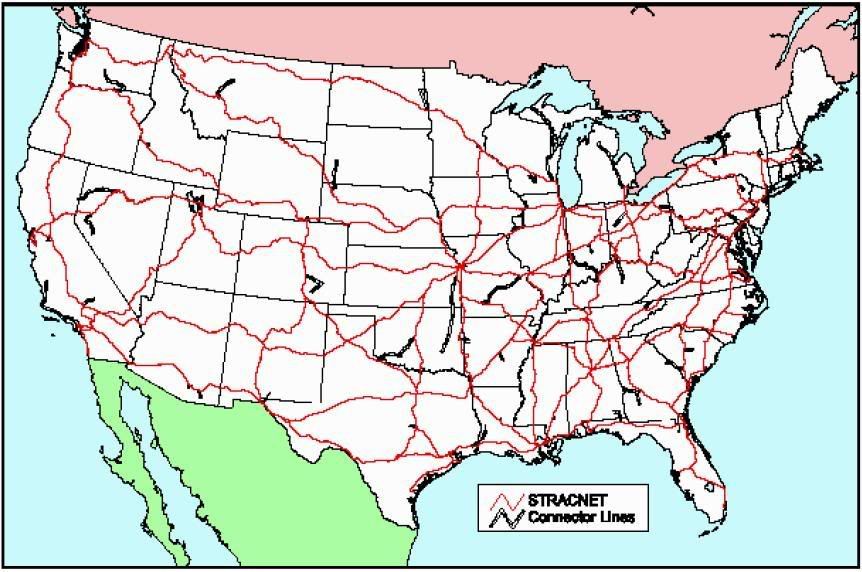 STRACNET Map:
STRACNET Map:I'll be talking about "STRACNET" below, the Department of Defense STrategic RAil Corridor NETwork, which is the system they developed for protecting their logistical needs in the half century that railroads were shedding track and corridors. The map is to the right. For those playing the home game, draw your own Steel Interstate system by selecting corridors from the red lines in this map.
Parasite Capitalism versus Economic Independence
Indeed, the focus of the Institutional Framework is ensuring that User Fees and Access Fees will refund the original capital cost, while at the same time ensuring that we do not have to dilly dally and delay on getting the process started.
So, yes, its a public investment in Economic Independence. But its a public investment, and part of the return actually is financial return. The Economic Independence helps to pay for itself. In that sense, it is closer to a Tollway than to the Free Rider type of Interstate.
What I want to argue, however, is that this is not unusual.
Parasite Capitalism and Oil Addiction
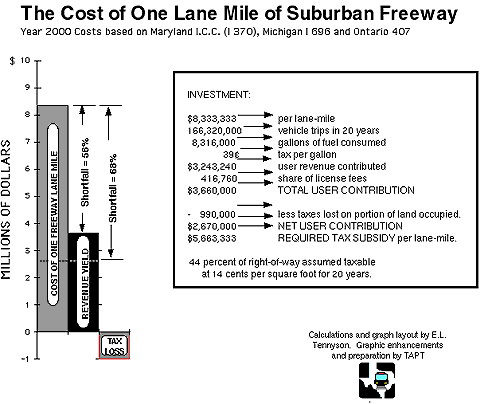 Certainly much of the "Great U-Turn" political economy that was established starting in the 1970's built upon the existing institutions of the Great American Middle Class economy that preceded it. However, it was very selective in the institutions it focused on: it focused on the art of taking the free ride.
Certainly much of the "Great U-Turn" political economy that was established starting in the 1970's built upon the existing institutions of the Great American Middle Class economy that preceded it. However, it was very selective in the institutions it focused on: it focused on the art of taking the free ride.Of course, there is no such thing as a genuinely free ride - what "free ride" means is simply that one party receives the benefit and a second party bears the cost. And the single word that encapsulates that relationship is "parasite". So we can call the economy of the 1970's to the present day, "Parasite Capitalism".
For instance, consider the Housing Bubble economy. This was just the most extreme elaboration of the standard sprawl property development system. And what is the standard sprawl property development system?
- Get the right to "develop" an undeveloped greenfield site
- Get someone to subsidize some road infrastructure
- Get someone to subsidize utility support infrastructure
- Get permission to do the development
- Build it and sell it
- Reap the reward of all your individualistic hard work
And the Highways based transport that the sprawl development relies upon itself relies on the art of the successful parasite. All highway users benefit from gas taxes paid by people driving on city streets that do not qualify for highway funding. The Federal Gas Tax helps people believe the myth that they are "paying" for the road and that its "their" road, when various state and local taxes cover the cost of the roads that generate the traffic on "non-highway" streets that generates the cross-subsidy to Interstate, US, State, County and Township Highways.
Note the last ... its not just Interstates. Lots of little country roads are subsidized by urban motorists.
With urban drivers as the parasite hosts and suburban drivers as the parasites, of course, growing numbers over time have moved to the suburbs, to get from the cost side to the benefit side. Which is great for short term windfall gains for property "developers", because that props up demand in the suburban areas where they have a well entrenched parasite capitalism system in place.
But its not long-term sustainable. Eventually, as the number of hosts dwindles and the number of parasites increases, the benefit available per parasite starts to drop. So it becomes harder and harder to meet all the demands on the highway trust fund with the proceeds of the gas tax that funds it. Add on top the decision to not index the tax rate for inflation ... which could be seen as a short-sighted measure to offset the ongoing increases in the real price of crude oil ... and there is less and less free riding opportunity.
What Did You Call Me?!!
To avoid confusion, I must stress that this is not a moral argument. One of the big shell games of the Great U-Turn is to moralize arguments, so that public consideration of problems does not involve looking at problems and looking for solutions, but instead involves looking at problems and looking for scapegoats.
This is the way the system is built. Its not the product of unconstrained individual personal choice. Looking to place individual blame in each individual suburban resident is like looking for the square of the checkerboard gives it the checkerboard pattern.
We definitely have to rebuild the system, but good people for many years have been fighting the fact that the system is built this way, and its just a hard fight, with no guarantees of victory.
Economic Independence is a big part of advancing from Parasite Capitalism to a system that is sustainable, and Energy Independence is a critical part of that.
Tailoring the Steel Interstates
 This is the target of the Steel Interstate system: the long haul truck freight loads. That's where there is massive energy waste to be mined, since a long haul diesel semi truck requires over 10 times the energy to haul a ton of freight as Rapid Electric Rail Freight.
This is the target of the Steel Interstate system: the long haul truck freight loads. That's where there is massive energy waste to be mined, since a long haul diesel semi truck requires over 10 times the energy to haul a ton of freight as Rapid Electric Rail Freight.And the users are going to be paying its up-front capital costs, that's the financial value that the private railroads are going to be chasing in order to provide the payments. They are a bunch of corporations, after all, and like any other psychopathic corporation, they will provide precisely as much public benefit as the chase of dollars leads them to do.
Lots of points jump out that demand changes in the map that I drew last week:
- First, the most important southwesterly line of freight in the Eastern US is the Shenandoah Valley extending into the Tennessee Valley, running inland of the population concentrations on the eastern seaboard
- Second, there are important southern seaboard ports, and the line I draw, taken directly from the Southeastern HSR corridor plan, does not provide direct access for most of them.
- Third, the first Stage ought to have lots of length to it, because until the network starts building up, its the longer runs that will be most vulnerable to competition from Steel Interstate rail ... and the more business the Steel Interstate rail wins, the more quickly they pay the capital cost of the line
I also thought that it makes more sense to start up all the four lines on a project development and planning basis, and the launch each with an increment of the interest subsidy funding from the imported oil tariff. So that is four stages rather than five, with all four Development Banks receiving $0.0025 from the initial penny per gallon, and then the four stages each hitting high gear as they get their additional penny in each following year.
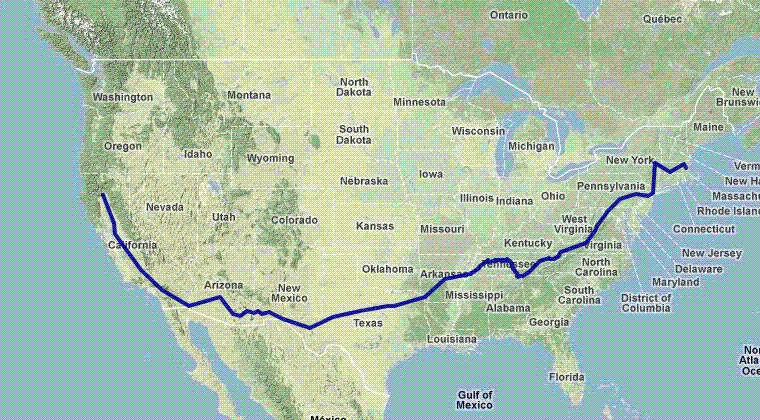 So this is what I've done. I've started in Boston at the extreme Northeastern edge of the STRACNET system, come down to New York via Albany (the NEC is awfully crowded, after all, and this is for long haul freight), then to Harrisburg, Pennsylvania to enter the broad central valley of the Appalachian mountains. Follow that down to Chatanooga, then to Nashville and Memphis to run through to Dallas, then down to El Paso and run via Tuscon and Phoenix to Southern California, then up the Central Valley to northern California.
So this is what I've done. I've started in Boston at the extreme Northeastern edge of the STRACNET system, come down to New York via Albany (the NEC is awfully crowded, after all, and this is for long haul freight), then to Harrisburg, Pennsylvania to enter the broad central valley of the Appalachian mountains. Follow that down to Chatanooga, then to Nashville and Memphis to run through to Dallas, then down to El Paso and run via Tuscon and Phoenix to Southern California, then up the Central Valley to northern California.I call this the "Liberty Line", as a major step toward Economic Freedom.
This corridor is first in part because it makes plenty of sense to do it even if roll-out stalls with the first line due to political fighting the main Parasite Capitalists threatened, including those US Oil Companies with substantial overseas oil production interests and hence a strong financial interest in our Economic Addiction to Oil Imports.
Looking at the freight map, there are massive truck freight loads that run entirely north of the Liberty Line, as well as a substantial amount of the traffic that runs on part of the Liberty Line that comes in from further north. So next comes a North/South corridor that I call the "Heartland" Line.
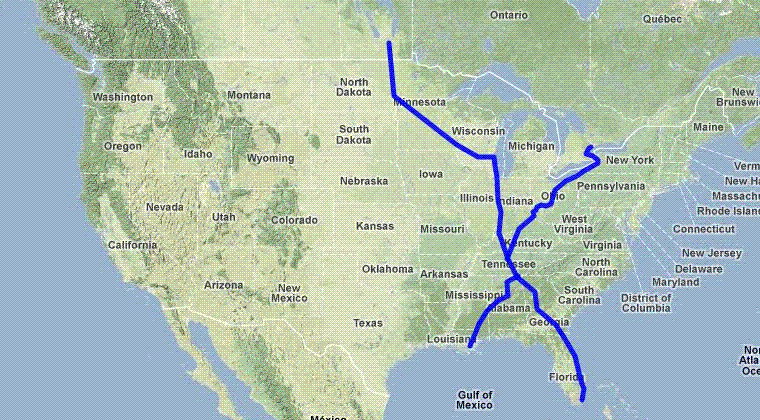 The Heartland Line runs up from Miami to Nashville via Atlanta, then up to Chicago by the most direct STRACNET route, then up to Minneapolis, and finally grabbing land port business by running up to terminate at Winnipeg in Canada.
The Heartland Line runs up from Miami to Nashville via Atlanta, then up to Chicago by the most direct STRACNET route, then up to Minneapolis, and finally grabbing land port business by running up to terminate at Winnipeg in Canada.The second leg of the Heartland Line starts in New Orleans, Louisiana, running up to Nashville and then to Cincinnati via Louisville, Columbus, Cleveland, Buffalo, and then Toronto.
With the Heartland Line development in progress, now is time to launch the National Line stage, which in the first draft was presented as Stage 1. There is a major adjustment here, since looking at the truck freight flows suggests that it is better to access the Pacific Northwest via southern Idaho, and so the National Line is now drawn to fork west of Cheyenne, with the north fork going to Portland, Oregon, and the south fork going to Sacramento to cross the Liberty Line and the Port of Oakland.
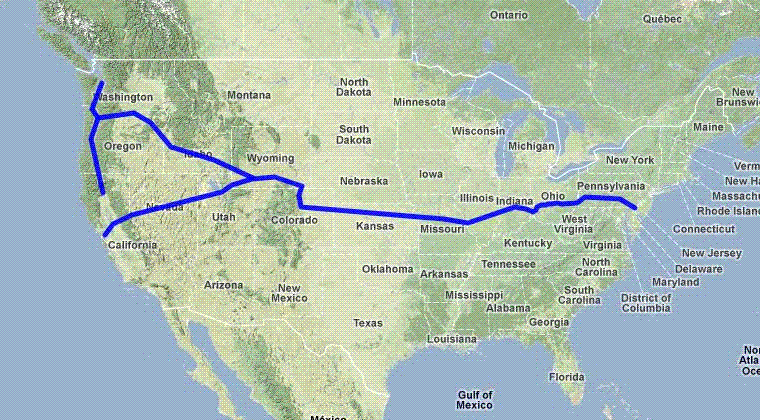 The National Line begins at the port of Wilmington, Deleware, which is the most convenient port to Liberty Line junction at Harrisburg. The line crosses to the railhead of Pittsburgh, then follows the National Line through Wheeling and to Columbus, where it a junction with one leg of the Heartland Line. From there I've drawn it as taking the existing STRACNET corridor past Dayton, until it hits the Stracnet Corridor through Indianapolis, and then through the Terre Haute where it has the junction with the other leg of the Heartland Line.
The National Line begins at the port of Wilmington, Deleware, which is the most convenient port to Liberty Line junction at Harrisburg. The line crosses to the railhead of Pittsburgh, then follows the National Line through Wheeling and to Columbus, where it a junction with one leg of the Heartland Line. From there I've drawn it as taking the existing STRACNET corridor past Dayton, until it hits the Stracnet Corridor through Indianapolis, and then through the Terre Haute where it has the junction with the other leg of the Heartland Line.From there the line continues through St. Louis, Kansas City, Denver, up to Cheyenne to run around the Colorado Rockies toward the strongest east/west freight market north of the southern tier of states. From there, as described, it forks, heading up through southern Idaho to connect to the Pacific Northwest, and through Salt Lake City toward Sacramento and then the main Northern California Pacific port of Oakland.
Now I have two main tasks to complete. First, I have a number of southeastern coastal ports that are not on the system and are too important to omit from the system. And second, if there is not going to be a Line running along the biggest of the east/west truck traffic flows west of the Mississippi, on Interstate 40, then there has to be crossing lines that can capture that freight. The Liberty Line can capture western Interstate 40 traffic to or from the Northeast, but there is nothing to intercept freight to or from the southeast.
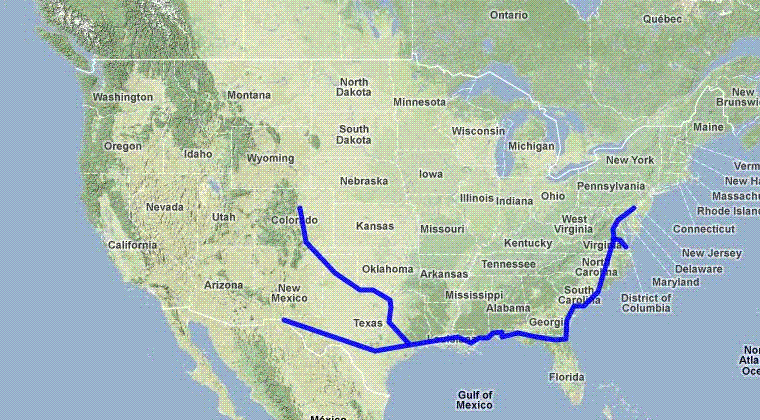 So the Gulf and Atlantic line runs along the Southeastern Atlantic Coast to junction with the Heartland Line at Jacksonville, then to Mobile, New Orleans, Houston, and connecting to the Liberty Line at El Paso. It has a second leg from Houston that runs to Dallas, crosses I-40 at Lubbock, and continues up to junction with the National Line at Denver.
So the Gulf and Atlantic line runs along the Southeastern Atlantic Coast to junction with the Heartland Line at Jacksonville, then to Mobile, New Orleans, Houston, and connecting to the Liberty Line at El Paso. It has a second leg from Houston that runs to Dallas, crosses I-40 at Lubbock, and continues up to junction with the National Line at Denver. Which completes the system. It may look like a tangle, but in the Institutional framework, there are four organizations which have the goal in front of them to finish their corridor. And note that as a form of Regional Development Bank, they will not be exercising the Federal government's powers of eminent domain, so they have to focus on hammering out the way of meeting their charter that is sufficiently appealing to the freight railroads to be able to build their line.
And now the headliners: Dreamworld / Midnight Oil


1 comment:
Làm sao để tìm dịch vụ van chuyen hang di Da Nang hoặc nơi nhận chuyển hàng đi Hà Nội. Vậy thì hãy liên hệ với Proship chúng tôi. Với các dịch vụ đang cung cấp hiện nay của chúng tôi như dịch vụ ship hàng tại hà nội, cho thuê kho bãi, cho thuê đất trống, chuyển phát nhanh trong nước, ship hàng nội thành tphcm, dịch vụ ký gửi hàng hóa, dịch vụ bốc xếp, cho thuê kho quận 10. Đảm bảo khi đến với chúng tôi bạn sẽ hài lòng vì chúng tôi có tất cả các dịch vụ vận chuyển lưu trữ mà bạn đang cần.
Post a Comment